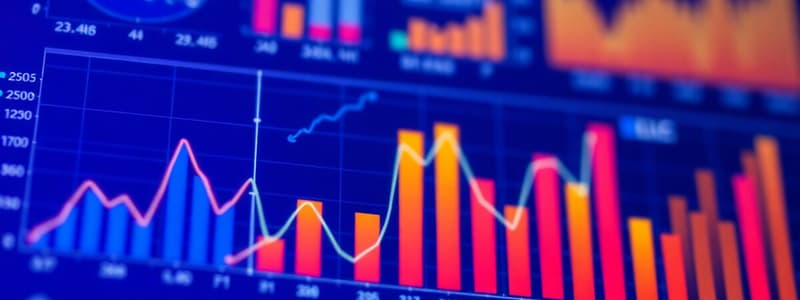Podcast
Questions and Answers
What is a characteristic of nonprobability sampling methods?
What is a characteristic of nonprobability sampling methods?
- Members are selected in a random manner.
- It is a costlier method of sampling.
- Every member has an equal chance of selection.
- Members are selected in a nonrandom manner. (correct)
Which sampling method ensures that every member of the population has an equal chance of being selected?
Which sampling method ensures that every member of the population has an equal chance of being selected?
- Quota sampling
- Simple random sampling (correct)
- Judgment sampling
- Snowball sampling
What is the main advantage of multiphase sampling?
What is the main advantage of multiphase sampling?
- It combines whole sample data with subsample data. (correct)
- It is more costly but thorough.
- It is entirely random.
- It requires prior knowledge of the entire population.
Which of the following is NOT a method of nonprobability sampling?
Which of the following is NOT a method of nonprobability sampling?
What is an example of a nonprobability sampling technique?
What is an example of a nonprobability sampling technique?
What impact does a smaller N have on the moving average forecast?
What impact does a smaller N have on the moving average forecast?
When calculating Mean Absolute Deviation (MAD), what is the formula used?
When calculating Mean Absolute Deviation (MAD), what is the formula used?
What is required for a weighted moving average calculation?
What is required for a weighted moving average calculation?
What type of error does the tracking signal (TS) highlight?
What type of error does the tracking signal (TS) highlight?
Which of the following sampling methods is NOT a probability sample?
Which of the following sampling methods is NOT a probability sample?
What does the formula E = A - F represent in forecasting?
What does the formula E = A - F represent in forecasting?
Why might an increase in sample size enhance forecasting accuracy?
Why might an increase in sample size enhance forecasting accuracy?
Which statement best describes the Mean Square Error (MSE)?
Which statement best describes the Mean Square Error (MSE)?
Which of the following is not a type of data in statistics?
Which of the following is not a type of data in statistics?
What characteristic of forecasting indicates it is usually more accurate over shorter periods?
What characteristic of forecasting indicates it is usually more accurate over shorter periods?
What is the main purpose of monitoring forecast accuracy over time?
What is the main purpose of monitoring forecast accuracy over time?
Which of the following forecasting methods uses subjective judgment?
Which of the following forecasting methods uses subjective judgment?
In the composition of time series data, what does 'historic pattern' refer to?
In the composition of time series data, what does 'historic pattern' refer to?
Which level forecasting method uses only the last observed data point?
Which level forecasting method uses only the last observed data point?
Which statement accurately reflects a property of forecasts?
Which statement accurately reflects a property of forecasts?
What formula is represented by the naive forecasting method?
What formula is represented by the naive forecasting method?
Study Notes
Basics of Statistics
- Data can be numerical (discrete or continuous) or categorical (nominal or ordinal).
- Mean, median, and mode are measures of central tendency.
- Variance and standard deviation measure the spread of data.
- Dependent and independent variables are used in statistical modeling.
- Correlation measures the strength of the relationship between variables.
Decisions Needing Forecasts
- Forecasts help make important decisions, like which markets to target, what products to produce, how many employees to hire, and what quantities to purchase/produce.
Common Characteristics of Forecasts
- Forecasts are rarely perfect.
- Forecasts are more accurate for aggregated (combined) data than individual items.
- Forecasts are more accurate for shorter rather than longer time periods.
Forecasting Steps
- Identify what needs to be forecast.
- Determine the available data.
- Select and test appropriate forecasting models.
- Generate the actual forecasts.
- Monitor forecast accuracy over time.
Types of Forecasting Models
- Qualitative models use subjective judgment and expert opinion to forecast.
- Quantitative models use statistical methods and mathematical equations.
Qualitative Forecasting Models
- Include Delphi method, jury of executive opinion, sales force composite, and consumer surveys.
Statistical Forecasting Models
- Time series models consider historical data to predict future values.
- Causal models forecast based on relationships with other variables.
Composition of Time Series Data
- Historical data consists of a pattern plus random variation.
- The pattern can include:
- Level: Long-term average value.
- Trend: Upward or downward movement over time.
- Seasonality: Recurring fluctuations within a year.
- Cycle: Long-term fluctuations beyond a year.
Time Series Patterns
- Illustrates the four components: level, trend, seasonality, and cycle.
Level Forecasting Methods
- Naïve forecast: Uses the previous period's value as the forecast.
- Simple mean: Calculates the average of all historical data.
- Moving average: Averages the last N periods' values.
- Weighted moving average: Assigns different weights to recent periods.
- Exponential smoothing: Gives more weight to recent data.
Time Series Example Problem
- Provides a dataset for forecasting demonstrations.
Naïve Forecasting
- The forecast for the next period is simply the actual value from the last period.
Simple Average
- The forecast is the average of all historical data.
Moving Average
- The forecast is the average of the last N periods of data.
- A smaller N makes the forecast more responsive to changes.
- A larger N makes the forecast more stable.
Weighted Moving Average
- The forecast is a weighted average of the last N periods with specific weights assigned to each period.
- The sum of weights should always equal 1.
Time Series Example Solution
- Demonstrates applying the level forecasting methods to the provided dataset.
Forecast Accuracy
- Forecasts are rarely perfect, and it's crucial to assess their reliability.
- Errors measure the difference between the actual and forecasted values.
- Over-forecasts: Negative errors.
- Under-forecasts: Positive errors.
Tracking Forecast Error
- Mean Absolute Deviation (MAD): Provides a good measure of the average error in a forecast.
- Mean Square Error (MSE): Penalizes extreme errors.
- Tracking Signal (TS): Identifies any bias (positive or negative) in forecasts.
- TS = (Actual - Forecast) / MAD.
Accuracy and Tracking Signal Example
- Illustrates how to calculate and interpret different error metrics and the tracking signal using a provided example.
Sampling Techniques
- Population: The entire group of interest.
- Sample: A subset of the population selected for study.
- Sampling unit: Non-overlapping collections of elements covering the entire population.
Probability vs. Nonprobability Sampling
- Probability sampling: Each population member has a known non-zero chance of being selected.
- Nonprobability sampling: Members are selected in a non-random way.
Sampling for Population
- Describes the importance of sampling techniques for studying a whole population.
Simple Random Sampling
- Each population member has an equal chance of being selected.
- It's the purest form of probability sampling.
- Can be done using software or randomly drawing numbers from lists.
Systematic Random Sampling
- Selecting every kth member after randomly choosing a starting point.
- Simple and efficient, but can be problematic if there's a pattern in the population.
Stratified Random Sampling
- Dividing the population into subgroups (strata) with similar characteristics and then randomly sampling from each stratum.
- Ensures representation of different subgroups.
Cluster Sampling
- Dividing the population into clusters and then randomly selecting entire clusters for investigation.
- Useful when dealing with large populations.
Strata vs. Cluster
- Compares stratified sampling (dividing the population) and cluster sampling (dividing the population into groups then selecting whole groups)
Multistage Sampling
- Involves multiple stages of sampling.
- First, large clusters are selected randomly, then smaller units within those clusters are also randomly sampled.
Multiphase Sampling
- Collecting different types of information from the sample in multiple phases.
- Useful for gathering detailed data from subgroups while minimizing costs.
Convenience Sampling
- Choosing participants based on ease of access and availability.
- Not representative and potentially biased.
Judgmental or Purposive Sampling
- Selecting participants based on the judgment of the researcher.
- Useful for specific expertise or knowledge.
Quota Sampling
- Selecting participants to match pre-determined quotas for specific characteristics within the population.
- Aims for representation but not necessarily random.
Snowball Sampling
- Identifying individuals with specific characteristics and then asking them to refer others with similar characteristics.
- Useful when reaching hard-to-find populations.
Thank You
- Concludes with speaker's name and contact details.
Studying That Suits You
Use AI to generate personalized quizzes and flashcards to suit your learning preferences.
Related Documents
Description
Explore the fundamental concepts of statistics including measures of central tendency, variance, and correlation. Delve into the importance of forecasting for decision-making and the common characteristics that define effective forecasts. Understand the steps involved in creating accurate forecasts for various scenarios.




